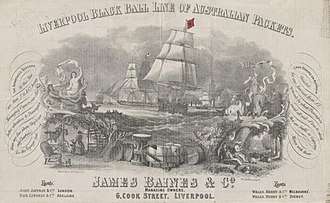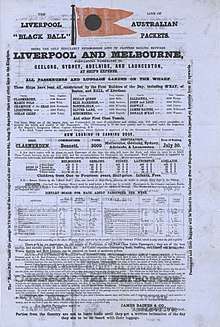James Baines & Co.
James Baines & Co. of Liverpool was the British shipping company, most famous for the Liverpool Black Ball Line of Australian Packets, a fleet of packet ships running cargo and passenger services between Liverpool, England and Australia in the second half of the 1800s.[1][2] It also traded in India and Crimea.
 | |
| Private | |
| Industry | Shipping, transportation |
| Fate | Closed |
| Founded | 1851 |
| Defunct | 1871 |
| Headquarters | 6 Cook Street, Liverpool, England, UK |
Key people | James Baines and Thomas Mackay |
Number of employees | up to 300 officers and 3000 seamen in 1860 |
| Subsidiaries | Liverpool Black Ball Line of Australian Packets |

Founders
The company was founded and headed by James Baines and Thomas Miller Mackay with two junior partners, Joseph Greaves and John Taylor. Its office was located at 6 Cook Street, Liverpool. In 1858, Mackay established a separate office of the company in London. The business practices of the company were often a subject of suspicious of the legality and flexibility of its operations.[3]
Name
In 1851 James Baines & Co. of Liverpool entered the packet trade using the same name and flag as the New York company, despite its protests. Thus, for about twenty years, two "Black Ball lines" under separate ownership were operating in direct competition on the transatlantic packet trade.
Symbols
The flag of the company was a red swallowtail with a black dot.[4]
The Australian line
The company started with its 1851 purchase of the ship Marco Polo. As the demand for passenger transport to Melbourne, Australia fueled by the 1850s gold rush grew,[5] Baines commissioned a famous American shipbuilder, Donald McKay to build four clippers for the line. The line rapidly became one of the most popular lines of its time, rising to the level of its rivalry White Star Line.[6] As the gold rush traffic subsided after 1856, James Baines & Co.signed an agreement with the Queensland colony in 1860 and ran a monopoly on that route, providing emigrants to the colony.[7] In 1864 there was an unsuccessful attempt to merge with White Star and Gibbs, Bright and Co. of Liverpool.[8]
Some of the ships of the Line also carried British troops during the Crimean War and the Indian Mutiny.
Fleet
James Baines & Co. operated some finest and most famous American clipper ships at the time, such as Champion of the Seas, Flying Cloud, James Baines, Lightning, Indian Queen, Marco Polo, Sovereign of the Seas and many others.[9] Some of the clippers Baines was able to buy at a very low price following the Panic of 1857 and the onset of American Civil war. Besides the American vessels, the fleet of the Line contained a number of softwood vessels built in the Maritime Provinces of Canada as well as oak and teak ships built in England and Scotland.[10]
Although, it is hard to estimate the exact size of the Line's fleet as they used charter ships extensively, on its peak in 1860, the Line had a fleet of 86 ships carrying cargo and passengers out to Australia.[11][12][13] Overall, more than 400 ships carried British immigrants to Australia during the 1850s and 1860s with the help of James Baines & Co.[3]
In 1864, with 13 ships James Baines & Co. was the biggest single buyer of U.S. ships.[3]

The conditions on the Line's ships often were quite appalling. The ships were dirty and poorly ventilated. It was not uncommon to have 500 passengers cramped on one vessel. On one instance, there were documented 26 death of the 460 passengers on board of Rockhampton, when she arrived in Keppel Bay on 12 October 1863 after the 116-day voyage from Liverpool.[10]
Decline
In 1866, Barned's Banking Company Ltd collapsed during the 1866 financial market crisis.[15] The Line was one of its main debtors and was forced to sell many of its ships. The crisis also affected the financial state of the Queensland Government, reducing its ability to financially to sustain the flow of immigrants.
The Line carried on under the management of teh secessors of James Banes & Co., James Baines, Taylor & Co. and T. M. Mackay, Son & Co., relying on chartered ships to maintain its sailing business, but it finally ceased trading in 1871. Baines and his partners also owned several ships separate from each other.
References
- John Leander Bishop; Edwin Troxell Freedley; Edward Young (1868). A history of American manufactures from 1608 to 1860...: comprising annals of the industry of the United States in machinery, manufactures and useful arts, with a notice of the important inventions, tariffs, and the results of each decennial census. E. Young. p. 296.
- Samuel Eliot Morison (1922). The maritime history of Massachusetts, 1783-1860. Houghton Mifflin Company. p. 362.
- Milne, Graeme J. (2000). Trade and traders in mid-Victorian Liverpool : mercantile business and the making of a world port. Liverpool University Press. pp. 132, 133. ISBN 0-85323-606-2.
- "British shipping companies (B)". Retrieved 1 April 2013.
- A. G. Davies (17 January 1934). "Page 10: FAMOUS SAILING SHIPS". Sydney Mail.
- Smith, C. Fox (Cicely Fox), 1882-1954. (1924). Sailor town days. Methuen & Co. p. 119.CS1 maint: multiple names: authors list (link)
- "Page 7: THE "BLACK BALL" LINE MONOPOLY". The Courier (Brisbane, Qld. : 1861 - 1864). 18 March 1864. Retrieved 23 May 2020.
- "Documents from John Bonus & Sons re the Black Ball Line (James Baines & Thomas MacKay)". National Museums Liverpool. Retrieved 24 May 2020.
- "The Ships List: Baines & MacKay / Black Ball Line, Liverpool". Retrieved 14 March 2016.
- Foote, Warwick (1978). Vessels that were owned or chartered by the Black Ball Line and brought immigrants to Queensland between November 1861 and March 1871, with dates and ports of arrival (PDF). pp. 21–45.
- THORP, Robert (2018). MERSEY BUILT : the role of merseyside in the american civil war [paperback, b & w edition]. VERNON Press. pp. 65–68. ISBN 1-62273-333-9.
- Lubbock, Basil, 1876-1944. The colonial clippers. Brown, Son & Ferguson. pp. 23–27.CS1 maint: multiple names: authors list (link)
- Chronicle (Adelaide, SA : 1895 - 1954) 14 Apr 1932, Page 54: SAILING SHIP ROMANCE
- "Baines & MacKay / Black Ball Line, Liverpool". www.theshipslist.com. Retrieved 23 May 2020.
- Turner, John D., 1971- autor. (2014). Banking in crisis the rise and fall of British banking stability, 1800 to the present. Cambridge University Press. p. 82. ISBN 978-1-139-38087-4. OCLC 1127413750.CS1 maint: multiple names: authors list (link)
External links

- List of the ships of the Liverpool Black Line at TheShipsList
- Era of the Clipper Ships